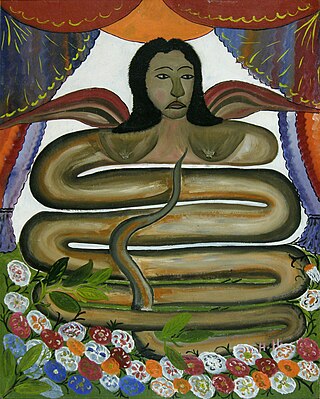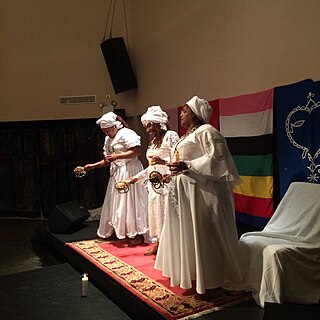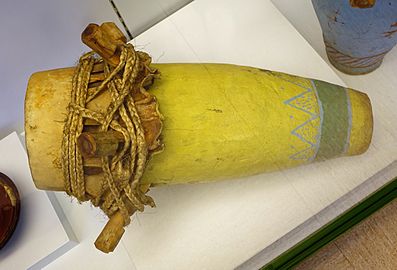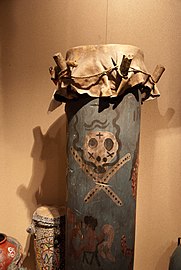
Lwa, also called loa, are spirits in the African diasporic religion of Haitian Vodou. They have also been incorporated into some revivalist forms of Louisiana Voodoo. Many of the lwa derive their identities in part from deities venerated in the traditional religions of West Africa, especially those of the Fon and Yoruba.

Ayida-Weddo, also known as Ayida, Ayida-Wedo, Aido Quedo, Aido Wedo, Aida Wedo, and Aido Hwedo, is a powerful loa spirit in Vodou, revered in regions across Africa and the Caribbean, namely in Benin and Haiti. Known as the "Rainbow Serpent", Ayida-Weddo is the loa of fertility, rainbows, wind, water, fire, wealth, thunder, and snakes. Alongside Damballa, Ayida-Weddo is regarded among the most ancient and significant loa. Considered in many sources as the female half of Damballa's twin spirit, the names Da Ayida Hwedo, Dan Ayida Hwedo, and Dan Aida Wedo have also been used to refer to her. Thought to have existed before the Earth, Ayida-Weddo assisted the creator goddess Mawu-Lisa in the formation of the world, and is responsible for holding together the Earth and heavens. Ayida-Weddo bestows love and well-being upon her followers, teaching fluidity and the connection between body and spirit.

Papa Legba is a lwa in Haitian Vodou, Dominican Vodou, Winti and Louisiana Voodoo, who serves as the intermediary between God and humanity. He stands at a spiritual crossroads and gives permission to speak with the spirits of Guineé, and is believed to speak all human languages. In Haiti, he is the great elocutioner. Legba facilitates communication, speech, and understanding. He is commonly associated with dogs. Papa Legba is invoked at the beginning of every ceremony. Papa Legba has his origins in the historic West African kingdom of Dahomey, located within present-day Benin.

Maman Brigitte sometimes also written as Manman Brigitte and also known by Gran Brigitte, Grann Brigitte, Manman, Manman Brigit, and Maman Brijit is a death loa and the consort of Baron Samedi in Haitian Vodou. She drinks rum infused with hot peppers and is symbolized by a black rooster. Maman Brigitte protects graves in Haitian cemeteries that are marked by the cross of Baron Samedi. Graves that are protected by Brigitte are marked by a mound of stones. In Vodou practice, the first burials serve as offerings to either Baron Samedi or Maman Brigitte depending on the gender of the person being laid to rest. If the deceased person is male then the grave is dedicated to Baron Samedi; if the deceased person is female then the grave is dedicated to Maman Brigitte.
Haitian mythology consists of many folklore stories from different time periods, involving sacred dance and deities, all the way to Vodou. Haitian Vodou is a syncretic mixture of Roman Catholic rituals developed during the French colonial period, based on traditional African beliefs, with roots in Dahomey, Kongo and Yoruba traditions, and folkloric influence from the indigenous Taino peoples of Haiti. The lwa, or spirits with whom Vodou adherents work and practice, are not gods but servants of the Supreme Creator Bondye. A lot of the Iwa identities come from deities formed in the West African traditional regions, especially the Fon and Yoruba. In keeping with the French-Catholic influence of the faith, Vodou practioneers are for the most part monotheists, believing that the lwa are great and powerful forces in the world with whom humans interact and vice versa, resulting in a symbiotic relationship intended to bring both humans and the lwa back to Bondye. "Vodou is a religious practice, a faith that points toward an intimate knowledge of God, and offers its practitioners a means to come into communion with the Divine, through an ever evolving paradigm of dance, song and prayers."

A veve is a religious symbol commonly used in different branches of Vodun throughout the African diaspora, such as Haitian Vodou and Louisiana Voodoo. The veve acts as a "beacon" for the lwa, and will serve as a lwa's representation during rituals.

Oungan is the term for a male priest in Haitian Vodou. The term is derived from Gbe languages. The word hounnongan means chief priest. ‘'Hounnongan or oungans are also known as makandals.

A manbo is a priestess in the Haitian Vodou religion. Haitian Vodou's conceptions of priesthood stem from the religious traditions of enslaved people from Dahomey, in what is today Benin. For instance, the term manbo derives from the Fon word nanbo. Like their West African counterparts, Haitian manbos are female leaders in Vodou temples who perform healing work and guide others during complex rituals. This form of female leadership is prevalent in urban centers such as Port-au-Prince. Typically, there is no hierarchy among manbos and oungans. These priestesses and priests serve as the heads of autonomous religious groups and exert their authority over the devotees or spiritual servants in their hounfo (temples).
The Rada are a family of lwa spirits in the religion of Haitian Vodou. They are regarded as being sweet-tempered and "cool", in this contrasting with the Petro lwa, which are regarded as volatile and "hot".

Haitian Vodou is an African diasporic religion that developed in Haiti between the 16th and 19th centuries. It arose through a process of syncretism between several traditional religions of West and Central Africa and Roman Catholicism. There is no central authority in control of the religion and much diversity exists among practitioners, who are known as Vodouists, Vodouisants, or Serviteurs.
Marilyn Jensen Houlberg was a professor, art historian, anthropologist, photographer, and curator. She was born and raised in Chicago, Illinois. Houlberg traveled extensively, conducting art historical and anthropological research in countries across the Caribbean and western Africa. She is known for curating exhibitions based on the religious icons and visual practices of Haitian Vodou and her anthropological research on the culture of the Yoruba people in southwestern Nigeria. Her photography archives and visual art collections are housed in various institutions throughout the United States. She was Professor Emeritus of Art History, Theory, and Criticism at the School of the Art Institute of Chicago, where she taught for over twenty years.
Haitian art is a complex tradition, reflecting African roots with strong Indigenous, American and European aesthetic and religious influences. It is an important expression of Haitian culture and history.
Various LGBT themes are present in different in African diasporic mythologies, primary among them being Voodoo.
Karen McCarthy Brown was an anthropologist specializing in the anthropology of religion. She is best known for her groundbreaking book Mama Lola: A Vodou Priestess in Brooklyn, which made great strides in destigmatizing Haitian Vodou. Until her retirement in 2009 due to illness, McCarthy Brown was a Professor of Anthropology at Drew University. At Drew University, McCarthy Brown was the first woman in the Theological School to receive tenure and to achieve the rank of full professor.
The religion of Haitian Vodou has been present in Cuba since at least the 18th century. It was transmitted to the island by Haitian migrants, the numbers of whom grew rapidly in the early 20th century, and is primarily practised by their descendants. It is distributed primarily in eastern parts of the island, especially in Oriente. In Cuba, some practitioners of Haitian Vodou have also become involved in the related Afro-Cuban religion of Santería.
Pierrot Barra (1942–1999) was a Haitian Vodou artist and priest, who was president of a Bizango society. He was well-known for his use of diverse materials to create “Vodou Things,” which functioned as charms or altars for the Vodou religion.
Evelyn Alcide is a Haitian drapo Vodou artist. Alcide studied under compatriot Myrlande Constant. Alcide often focuses her work on important Vodou religious figures. Her drapo are heavily beaded and have satin borders. Two of her flags depicting Lasirène were included in Mami Wata: Arts for Water Spirits in Africa and Its Diasporas a traveling exhibition originated at the Fowler Museum at UCLA that travelled to several venues including National Museum of African Art.
Myrlande Constant is a Haitian textile artist who specializes in Vodou themed flags, or drapo Vodou. Since she began making Vodou flags in the 1990s, she has transformed and surpassed this medium, preferring to make large-scale tableau, she describes her work as "painting with beads." Constant is married and the mother of four children.
Mireille Delismé,, is a Haitian drapo Vodou artist from Léogâne, Haiti.
Voodoo in popular culture encompasses various representations of practices associated with different forms of voodoo, including Haitian Vodou and Louisiana Voodoo, and other elements attributed to African diaspora religions, with such representations often deviating substantially from any actual voodoo practices or beliefs. Tropes regarding voodoo appear most often in supernatural fantasy or horror films, with common themes including the activity of witch doctors, the summoning or control of dark spirits, use of voodoo dolls to inflict pain on people remotely, and the creation of zombies.

















